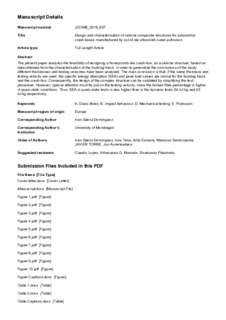
Título
Design and characterisation of cellular composite structures for automotive crashboxes manufactured by out of die ultraviolet cured pultrusionAutor-a
Autor-a (de otra institución)
Otras instituciones
Irurena GroupVersión
Postprint
Derechos
© 2018 Elsevier Ltd.Acceso
Acceso embargadoVersión del editor
https://doi.org/10.1016/j.compositesb.2018.10.046Publicado en
Composites Part B: Engineering Vol. 160. Pp. 217-224. 1 March 2019Primera página
217Última página
224Editor
Elsevier B.V.Palabras clave
Glass fibresImpact behaviour
Mechanical testing
Pultrusion
Resumen
The present paper analyses the feasibility of designing a honeycomb-like crash-box, as a cellular structure, based on data obtained from the characterisation of the building block. In order to general ... [+]
The present paper analyses the feasibility of designing a honeycomb-like crash-box, as a cellular structure, based on data obtained from the characterisation of the building block. In order to generalise the conclusions of the study, different thicknesses and testing velocities have been analysed. The main conclusion is that, if the same thickness and testing velocity are used, the specific energy absorption (SEA) and peak load values are similar for the building block and the crash-box. Consequently, the design of the complex structure can be validated by simplifying the test procedure. However, special attention must be put on the testing velocity, since the broken fibre percentage is higher in quasi-static conditions. Thus, SEA in quasi-static conditions is higher than in dynamic conditions, 64 kJ/kg and 45 kJ/kg respectively. [-]
Sponsorship
Unión EuropeaID Proyecto
info:eu-repo/grantAgreement/EC/H2020/653926/EU/Ultralight and Ultrasafe Efficient Electric Vehicle/WEEVILColecciones
- Artículos - Ingeniería [745]
El ítem tiene asociados los siguientes ficheros de licencia:





















